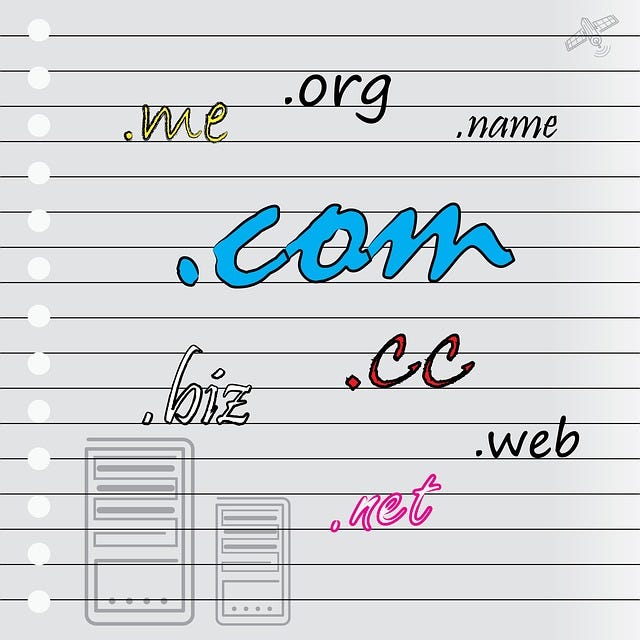
The art of making money on the internet has evolved a lot. Almost every business is doing some portion of their business over the internet, be it just having a humble website to connect with customers or running a full-blown business that can only function over the internet such as the Ubers of the world. Within that second category, there is a subset of businesses that are part of the internet itself. In that group are companies that offer things like web hosting, email services, and domain registration. It’s this last group that is on my radar today.
If you want to do any kind of business on the internet, you’re probably going to need a domain name because that is the fundamental piece of the puzzle that allows you to carve out a home on the internet. A domain name not only allows you to put up a website at that name but also set up ancillary services such as email.
This is not a Domain Name System (DNS) post, but to get us all on the same page, a domain name is what links your human-readable domain name to the internet readable IP address of where your site and email reside. At its core, the DNS is just a big old global lookup table. Your computer consults it as needed to find out what IP address is associated with whatever service you just requested.
There are no free rides on the internet and if you want a domain name, you’re going to have to pay for it. Unlike a coffee cup or a bike, you’ll never own a domain name. You can only lease it for a set period of time, usually a year, and have to constantly renew it if you want to keep using it. Knowing what we know about the big old lookup table, we can now start to infer that “purchasing” a domain name actually means “paying some company to put an entry in the global DNS database for my domain name for some set period of time”. Domains are kinda like beer - you only rent it.
Initial Purchase Cost
This brings me to my first point - cost. What should a domain name cost?
Selling domains is incredibly profitable which is why there are literally thousands of places to buy a domain name, although most of those companies funnel into just a few gorilla-sized companies on the back end. The competition is fierce and out of that comes a fairly low price-point for most domains.
There are a bunch of factors that affect the cost of a domain. Using NameCheap’s “Beast Mode” to search for domains we can see that the cost of a jon domain runs anywhere from $14.98 a year all the way up to almost $5,000. There is no technical difference in what happens when I buy any of these domains. The pricing is strictly a factor of how much the seller thinks they can get for it, for the reasons I am about to cover.

Does it have a history or is it new?
If you’re registering a domain for the first time, it’s going to be worth less than if it had a history. New domains are not yet known by the search engines like Google, and therefore will not show up highly in search results initially, which will make it harder to draw traffic to that site. For that reason, new domains are usually worth less than one with a few years of history.
How long is it?
Shorter domain names usually cost more. This is because shorter names are easier to remember and therefore domain sellers will charge more for them.
What is the Top Level Domain (TLD)?
A TLD is the last part of a domain. For example, using google.com - the TLD is com. Back in the days of yore the internet was very well organized. There were only a few TLDs such as .com, .org. and .net. Later on, Country Code TLDs (called ccTLDs) arrived and every country in the world was assigned a TLD such as the .ca TLD for Canada. Fast forward to today and the market is wide open. Anyone with $50,000 US can apply to create a new generic TLD (called gTLDs) and then try to sell domains under that TLD to recoup their money.
The screen-shots below show the drastic variation in the value of two identical domains, except for the TLD: paintwindsor.com and paintwindsor.ca. The .com is estimated to be worth over $1,000 and the .ca is estimated to be worth just 1/10th of that.


How much can the seller get for it?
There is always some give and take when pricing anything, not just domains. A litre of milk costs the same to produce regardless of where I buy it, but I will pay a different amount for that litre of milk depending on where I buy it in my province. Some of that price difference is legitimate because it costs more to bring that litre of milk to the shelf in various different regions, but some of that is because that shelf happens to be in a slightly more affluent or isolated neighbourhood and people are willing to pay more for it, so companies take advantage of that to increase profits.
Overpaying
Private domain sales can be all over the board, but that is an area that only experienced speculators should be in, so that is not part of my post today. However, because the competition is fierce for domain names, most of the registrars price their domains similarly. But that does not mean you can’t overpay for a domain name.
A good example of a registrar that bucks the trend and prices their domains far higher than the rest of the industry is a company that has changed names many times over the years, and is now operating under the name Domain Registry. I receive postal mail “courtesy renewal reminders” from Domain Registry several times a year informing me that I need to renew my domain.
The problem with this is that I have never registered any of my domains through the Domain Registry. It is my opinion that these renewal notices are attempts to trick companies into transferring their domain names to the Domain Registry by presenting these “courtesy renewal reminders” as invoices. There are a number of people in Canada and the US that have already written about this company and their domain name giv.com here and here.
The second link goes into detail about how this company changes its name periodically.
The Domain Registry of Canada (DROC) has been running the same scam for over a decade. They have used various company names such as "Internet Registry of Canada", "Domain Registry of America", "Domain Renewal Group", "Domain Registry of Europe", "NameJuice", "Brandon Gray Internet Services", or "DROC". But in any case they always use the same technique to fool domain owners into transferring their domain away.
There are a lot of people who consider this company to be scammers. Be aware that if you own a domain you may receive one of these letters from Domain Registry because that company will harvest your ownership data from somewhere. Unless you registered your domain with Domain Registry initially, or really want to overpay for your domain renewal, you can throw this letter out. Indeed the letter does state that this is not a bill, so it is technically on the right side of the law, but you decide for yourself. The letters look like this (for the record, the paintwindsor.com 1 year renewal rate at my registrar is about $15):

Renewal Value
I have noticed a trend in recent years where a registrar will have a sale on certain TLDs from time to time, such as offering all .xyz domains for $1.99. That is a common tactic to get people interested in a newly offered TLD to help it gain traction in the marketplace. But remember that you’re only renting this domain name you’re going to have to renew it if you want to keep it. And perhaps you will be renewing it for decades if you’ve invested a lot of branding into it within that first year. Registrars know that and a lot of times they’ll sucker you into a good first-year deal, and then jack the price incredibly at renewal time.
Let’s go back to my jon domain list and check for that. This jon.boutique domain is a good example. I’ll pay $6.88 to register it for the first year, but then pay over 4 times that much to renew it at $27.88 next year. Boo.

Transferring Domains
Remember when cell phone providers owned the phone number they assigned to you when you purchased a service contract? For the first decade or so of cell phone adoption, carriers would lure us in with a good short-term rate, and then slam us with a higher renewal cost (sound familiar?). But almost all of us paid the renewal because of one very important thing: the cell phone company owned the phone number. So sure, we could move to another company instead of renewing with our current providers, but then we’d lose our phone number. Mom would no longer reach us and all our business cards were now garbage. So, we sucked it up for a while until the CRTC in Canada forced providers to allow “porting” of cell phone numbers and we can now take our number with us. That was good for consumers and the domain registration system has the same protection built into it.
Domain name owners can transfer domains to another registrar. For example, I purchased most of my domains at NameCheap (affiliate link) but sometimes I find a really good deal at another registrar on a domain so I buy it at the other registrar. But, when the first year is over, the renewal deal isn’t so good and it may be cheaper to renew it at NameCheap instead of the registrar where I purchased it initially. That is possible and it is called “transferring” a domain. It usually pays to wait until near the end of the registration period to do domain transfers because you will need to pay for at least one year at the new registrar to transfer that domain. The closer the domain is to expiring when you transfer it, the less money you’ll be out due to the overlap.
Before the domain expires, I simply need to log into my NameCheap account and initiate a transfer of that domain from its current registrar to NameCheap. That’s pretty much the same thing as porting a cell phone number to another carrier and it offers some protection against predatory renewal fees.
Extra Features
All domain registrars are not equal. The pricing is usually very similar, and they all offer some basic stuff like the ability to manage your DNS records and usually provide a “parking” page that will be displayed if people go to your domain before you’re ready with your own site. But, from there, things can vary a lot.
One of the most useful features that some registrars offer is email forwarding. This allows you to instantly get email working for your new domain without the issue of purchasing or setting up an email account somewhere. If you want to use email with your new domain and your registrar does not include this feature, then you’ll have to go through the process of setting up email accounts or forwarders somewhere else, and then adjusting your DNS records at your registrar to make it all work. It is much easier to use a registrar that includes email forwarding such as, you guessed it, my fave NameCheap.
Some registrars, like Hover, nickel and dime you for features like that, charging $5/year for each email forwarder. That, dear reader, is highway robbery. You can create many email forwarders for free at NameCheap.

Final Thoughts
This post was a bit of a rambler. There have been a lot of domain-adjacent things that have happened to me in the last few weeks, so the topic is high on my mind. Overall, the domain registration industry is healthy, and it is fairly stable and easy to manage. Just be on the lookout for the one or two bad guys out there trying to take advantage of you, and also don’t be afraid to create accounts at many registrars to see what features they each offer before deciding where to purchase. And, even if you do end up buying a domain somewhere but subsequently find a registrar you like better, don’t sweat it. You can transfer it.












Share this post